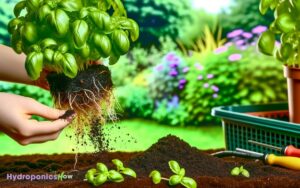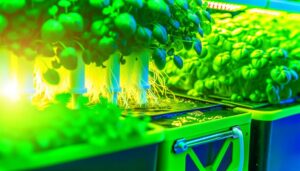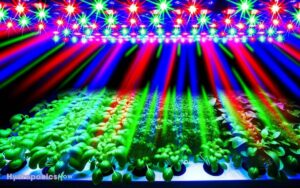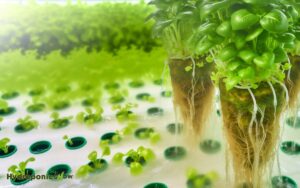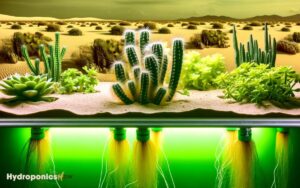Do I Need to Soak Seeds Before Planting in Hydroponics? Yes!
Yes, you should soak seeds before planting in hydroponics. Soaking accelerates germination by initiating imbibition, softening the seed coat, and guaranteeing uniform seedling development.
This process is crucial for enhanced germination rates and overall seedling health. Use distilled or dechlorinated water, maintain a temperature of 20-25°C, and make sure seeds are fully submerged.
However, be cautious with seeds prone to rot, such as lettuce or spinach, as soaking may cause mold growth. Direct seeding might be preferable for these.
Understanding the specific needs of your seeds guarantees successful hydroponic gardening. There are more insights on optimizing your germination process. By recognizing factors like moisture, temperature, and nutrient availability, you can create the ideal conditions for healthy seed development. Comparing hydroponics vs soil benefits reveals that hydroponic systems often lead to faster germination and higher yields due to controlled environments. Implementing these insights will help you maximize efficiency and ensure strong, thriving plants.

Key Takeaways
Benefits of Soaking Seeds
Soaking seeds before planting in hydroponics accelerates germination by softening the seed coat and initiating the imbibition process.
When you soak seeds, water penetrates the seed coat, causing it to swell and activate metabolic processes. This hydration triggers enzymatic activity that converts stored food into energy, essential for embryo growth.
By pre-soaking, you can achieve more uniform and faster germination, reducing the time to see seedlings.
Additionally, soaking can activate dormant seeds that might otherwise remain inactive. It’s especially beneficial for larger seeds with thicker coats, ensuring they don’t lag in development.
Implementing this method streamlines your hydroponic system’s efficiency, leading to healthier, more vigorous plants, and ultimately, a more productive harvest.
Drawbacks of Soaking Seeds
When soaking seeds, you risk over-absorption, which can lead to seed damage and reduced viability.
This method can also inadvertently delay germination time if seeds become waterlogged.
Additionally, excess moisture creates an environment conducive to mold growth, compromising seed health.
Potential Over-Absorption Issues
Over-absorption can lead to seed swelling, which might cause cell rupture and inhibit successful germination in hydroponic systems. When seeds absorb too much water, their cellular membranes can become excessively turgid, leading to structural damage.
This phenomenon, known as imbibitional injury, compromises cellular integrity and disrupts essential metabolic processes. Hydroponic conditions, characterized by constant moisture and nutrient availability, can exacerbate this issue.
You must monitor soaking duration carefully to prevent over-absorption. Shorter soaking times can mitigate the risk of cellular damage while still priming the seeds for germination.
Utilizing pre-measured water quantities and controlled environments helps maintain ideal hydration levels, thereby ensuring robust seedling establishment and growth in your hydroponic setup.
Delayed Germination Time
Despite the benefits of pre-soaking, improper seed hydration can inadvertently prolong germination time, posing challenges in hydroponic systems.
When seeds absorb too much water, they can experience osmotic stress, disrupting the imbibition process. This imbalance can delay the activation of key metabolic pathways essential for germination.
Additionally, over-soaked seeds may suffer from reduced oxygen availability, important for cellular respiration during germination.
In hydroponics, where precise control is paramount, these delays can lead to uneven growth cycles and reduced efficiency.
To mitigate these risks, monitoring soaking duration and water quality closely is crucial. Ensuring seeds are adequately but not excessively hydrated can optimize germination rates and improve overall system performance.
Risk of Mold Growth
Mold proliferation poses a significant risk during seed soaking, potentially compromising seed viability and introducing pathogens into hydroponic systems.
Mold thrives in moist environments, and soaking seeds creates ideal conditions for its growth. If you don’t monitor and manage moisture levels precisely, mold can quickly colonize the seeds.
This not only reduces germination rates but also threatens the entire hydroponic setup by introducing fungal pathogens.
You should use sterile water and sterilized containers to mitigate these risks. Additionally, consider adding a mild antifungal solution to the soak water. Even with these precautions, closely inspect seeds for mold before planting.
Types of Seeds to Soak
Certain seeds, such as those of beans, peas, and leafy greens, benefit greatly from pre-soaking due to their hard outer shells which can impede germination.
By immersing these seeds in water, you soften the seed coat, allowing moisture to penetrate more effectively. This process accelerates the germination timeline and enhances uniform sprouting.
For seeds with particularly tough exteriors, such as legumes, soaking is almost vital. Smaller seeds, like those of leafy greens (e.g., spinach, lettuce), also show improved germination rates with pre-soaking.
However, avoid soaking seeds that are prone to rotting or those with delicate structures.
In hydroponics, where controlled environments are essential, understanding which seeds to soak ensures a robust start, leading to healthier and more productive plants.
Hydroponic Systems and Soaking
In hydroponic systems, pre-soaking seeds can greatly enhance germination rates by ensuring that the seeds are adequately hydrated before entering the nutrient-rich solution.
When you soak seeds, the imbibition process initiates, allowing water to penetrate the seed coat and activate essential metabolic pathways.
This hydration jumpstarts enzymatic activities vital for breaking dormancy and fostering rapid growth.
In hydroponic setups, where precise control over environmental factors is paramount, pre-soaking can markedly reduce the time to germination. It also guarantees uniform seedling development, which is essential for maintaining consistent crop cycles.
How to Soak Seeds
To soak seeds effectively, you’ll typically need to immerse them in water for a specific duration, often ranging from 4 to 24 hours, depending on the seed type. Start by using distilled or dechlorinated water to prevent any potential contaminants.
Place the seeds in a clean container, ensuring they’re fully submerged. Monitor the water temperature; it should generally be around room temperature (20-25°C).
During soaking, seeds absorb water through their seed coat, initiating the germination process by activating enzymes and breaking dormancy.
After the designated soaking period, promptly transfer the seeds to your hydroponic system to prevent oversaturation, which can lead to rot.
Remember, soaking parameters may vary, so always consult specific guidelines for the seed variety you’re working with.
Alternative Methods to Soaking
You can explore alternative methods like pre-germination using paper towels, which promotes uniform sprouting by maintaining ideal moisture levels.
Another viable option is direct seeding techniques, where seeds are planted straight into the hydroponic medium, reducing transplant shock.
Both methods can enhance germination rates and streamline your hydroponic process.
Pre-germination Paper Towels
Pre-germination with paper towels offers a controlled environment to monitor seed moisture levels and root development before hydroponic planting.
To start, place your seeds between two damp paper towels, ensuring they remain moist but not waterlogged. This method allows you to observe the radicle (initial root) emergence, critical for evaluating seed viability.
Maintain a consistent temperature, ideally around 20-22°C (68-72°F), to optimize germination rates. Check daily for root growth and fungal contamination, which can be mitigated by using sterilized tools and containers.
Once the radicles reach approximately 1-2 cm, you can transfer seedlings to your hydroponic setup, ensuring seamless integration. This pre-germination technique enhances control over early growth stages, promoting healthier plants.
Direct Seeding Techniques
Unlike pre-germination methods, direct seeding techniques involve placing seeds straight into the hydroponic growing medium, leveraging essential environmental conditions to stimulate germination. This method bypasses the need for soaking, reducing handling stress on seeds.
To guarantee success, you’ll need to focus on:
- Optimal Temperature: Keep the growing medium between 68-75°F (20-24°C) to facilitate enzymatic activity and seedling emergence.
- Moisture Control: Maintain consistent moisture levels in the medium, avoiding both waterlogging and desiccation.
- Light Exposure: Use grow lights to provide 16-18 hours of light daily, simulating natural sunlight cycles critical for photosynthesis.
When Not to Soak Seeds
Certain types of seeds, such as those with delicate outer coatings or those that are prone to fungal infections, shouldn’t be soaked before planting in hydroponic systems.
Seeds like lettuce and some herbs have fragile exteriors that can be damaged by prolonged exposure to water, impairing germination.
Additionally, seeds susceptible to fungal pathogens, like spinach, are at higher risk of developing mold when soaked. Instead, direct seeding into a sterile growth medium can mitigate these risks.
You should also consider the seed’s inherent moisture content; overly hydrated seeds might rot before they sprout.
By understanding the specific requirements and vulnerabilities of your seeds, you can optimize your hydroponic setup for maximum germination success and plant health.
Conclusion
To sum up, soaking seeds before hydroponic planting can greatly enhance germination rates, much like priming an engine for peak performance.
For example, research shows that soaked lettuce seeds sprout 40% faster than dry ones. However, it’s not always necessary. Consider your specific seeds and hydroponic system.
Sometimes, skipping this step is like letting a seasoned athlete naturally find their rhythm. By understanding the nuances, you’ll guarantee your hydroponic garden thrives.


